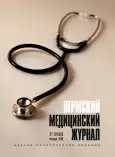Effectiveness of antiepidemic events in tuberculosis in context of changing epidemic process trend
- Authors: Dorofeeva I.K.1, Logvin F.V.1, Maksimova E.A.1, Chernigovets L.F.1, Tyutyunkova N.G.1, Batashev V.V.1, Chernaya A.S.1
-
Affiliations:
- Rostov State Medical University
- Issue: Vol 39, No 3 (2022)
- Pages: 102-113
- Section: Preventive and social medicine
- URL: https://journals.rcsi.science/PMJ/article/view/109372
- DOI: https://doi.org/10.17816/pmj393102-113
- ID: 109372
Cite item
Full Text
Abstract
Objective. To study the features of the formation of the epidemic situation for tuberculosis and to evaluate the effectiveness of antiepidemic events in separate age groups.
Materials and methods. A retrospective analysis of the incidence of tuberculosis in Rostov-on-Don from 1992 to 2017 was conducted. The dynamics of the incidence of active tuberculosis, respiratory system tuberculosis and forms with bacillus discharge with the determination of the trend and its quantitative assessment was studied; the age structure of tuberculosis patients was analyzed depending on the direction and severity of the trend.
Results. The incidence of tuberculosis has been increasing in Rostov-on-Don since 1993, and from 2003 to 2008, the average long-term incidence of active tuberculosis, respiratory tuberculosis and forms with bacillus excretion was maximum. Since 2009, the direction of trends has changed, the period from 2009 to 2013 is characterized by a "pronounced" downward trend and since 2014, the incidence rates have been minimal. In the age structure of patients with active tuberculosis, the proportion of persons aged 40-49 is decreasing, and in 2014–2017, the proportion of persons aged 50–59 years is also falling. Since 2009, the proportion of persons aged 18–29 has increased, and in 2009–2013 the proportion of children has grown. In 2014–2017, the proportion of persons over 60 years of age increased among those who fell ill.
Conclusion. The most effective events are carried out in the group of 40–59 years, less effective – among children and persons aged 15–17 and 30–39 years. The results of the research will allow us to adjust preventive measures among children, teenagers and young people.
Keywords
Full Text
##article.viewOnOriginalSite##About the authors
I. K. Dorofeeva
Rostov State Medical University
Author for correspondence.
Email: atlz3@mail.ru
ORCID iD: 0000-0003-3695-3834
Candidate of Medical Sciences, Associate Professor, Department of Epidemiology
Russian Federation, Rostov-on-DonF. V. Logvin
Rostov State Medical University
Email: atlz3@mail.ru
ORCID iD: 0000-0002-4410-1677
Candidate of Medical Sciences, Acting Head of Department of Epidemiology
Russian Federation, Rostov-on-DonE. A. Maksimova
Rostov State Medical University
Email: atlz3@mail.ru
ORCID iD: 0000-0003-3656-8143
Candidate of Medical Sciences, Associate Professor, Department of Epidemiology
Russian Federation, Rostov-on-DonL. F. Chernigovets
Rostov State Medical University
Email: atlz3@mail.ru
ORCID iD: 0000-0003-0246-1145
Candidate of Medical Sciences, Associate Professor, Department of Epidemiology
Russian Federation, Rostov-on-DonN. G. Tyutyunkova
Rostov State Medical University
Email: atlz3@mail.ru
ORCID iD: 0000-0002-0441-9197
Candidate of Medical Sciences, Associate Professor, Department of Epidemiology
Russian Federation, Rostov-on-DonV. V. Batashev
Rostov State Medical University
Email: atlz3@mail.ru
ORCID iD: 0000-0002-1840-9627
Candidate of Medical Sciences, Associate Professor, Department of Epidemiology
Russian Federation, Rostov-on-DonA. S. Chernaya
Rostov State Medical University
Email: atlz3@mail.ru
Assistant, Department of Epidemiology
Russian Federation, Rostov-on-DonReferences
- The global plan to stop TB 2011-2015: transforming the fight towards elimination of tuberculosis. WHO 2010.
- Galkin V.B., Mushkin A.Yu., Murav'ev A.N., Serdobintsev M.S., Belilovskiy E.M., Sinitsyn M.V. Sex and age structure of the incidence of tuberculosis of various localizations in the Russian Federation: dynamics in the 21st century. Tuberculosis and lung diseases 2018; 96 (11): 17–26 (in Russian).
- Ershova E.S., Pavlova M.V., Vladimirov A.V., Revyakin E.A. Epidemic situation and prospects for the treatment of multidrug-resistant tuberculosis in the Khanty-Mansiysk Autonomous Okrug. Tuberculosis and lung disease 2018; 96 (4): 5–11 (in Russian).
- Baranova I.S. Geograficheskie osobennosti zabolevaemosti tuberku-lezom v Rossii. Rossiya i mirovoe soobshchestvo: problemy demografii, ekologii i zdorov'ya naseleniya. Materialy Mezhdunarodnoy nauchno-prakticheskoy konferentsii. Penza 2018; 18–22 (in Russian).
- Belilovskiy E.M., Borisov S.E., Son I.M., Nechaeva O.B., Galkin V.B. i dr. Tuberculosis incidence in the Russian Federation. Tuberculosis in the Russian Federation, 2012/2013/2014. Analytical review of statistical indicators used in the Russian Federation and in the world. Moscow 2015; 29–74 (in Russian).
- Shilova M.V. Tuberculosis in the Russian Federation in 2010. Moscow 2012; 224 (in Russian).
- Global tuberculosis report 2016. WHO 2016; 201.
- Global Tuberculosis Report 2017: WHO/HTM/TB/2017.23. Geneva: WHO 2017; 249.
- Kondratenko T.A., Shul'ga L.V., Dorofeeva I.K., Chernigovets L.F., Maksimova E.A., Tyutyun'kova N.G., Logvin F.V. Features of the formation of the social structure of the incidence of tuberculosis in Rostov-on-Don. Materials of the XI Congress of the All-Russian Scientific and Practical Society of Epidemiologists, Microbiologists and Parasitologists. Ensuring epidemiological well-being: challenges and solutions. Moscow 2017; 389–390 (in Russian).
- Skachkova E.I., Novozhilov A.V. Formation and analysis of reporting forms on tuberculosis, requirements and principles. Social aspects of public health 2007; 96 (11): 3 (in Russian).
Supplementary files







